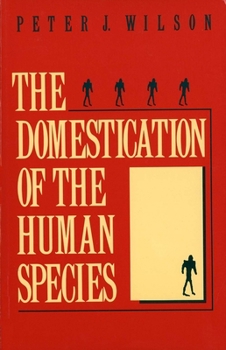The Domestication of the Human Species
Select Format
Select Condition 
Book Overview
In the exciting book Peter J. Wilson takes domestication as the starting point for his continued inquiry into human evolution. Wilson argues that settling down into a built environment was the most radical and far-reaching innovation in human development and that it had a crucial effect on human psychology and social relations. The insights of this book point the way toward amendments to social theories that will challenge the professional reader and at the same time offer to the general reader an enriched understanding of human behavior and human history.
"This book is a rare occurrence: a total rethinking of a set of closely related fundamental problems in the understanding of human evolution.... An] immensely ambitious undertaking."--Paul Wheatley, Contemporary Sociology
"This approach merges societies in surprising ways....It certainly leads to some provocative and stimulating generalizations."--John Bodley, American journal of Physical Anthropology
"Perhaps this book is revolutionary...asking us to rethink human nature, its causes, its cures...It holds out the real possibilities of redoing the human condition by reconceptualizing the power of our environs.... Wilson] has given is a book that is hard to put down once begun, and one whose ideas are even harder to dismiss."--Harvey B. Sarles, Contemporary Psychology
"This is definitely a book on which to sharpen one's wits....The author invites the reader to think with him about matters not only past but also present which have much relevance for our future. This book makes lively and mind-stretching reading."--Ashley Montagu
"This book is a rare occurrence: a total rethinking of a set of closely related fundamental problems in the understanding of human evolution.... An] immensely ambitious undertaking."--Paul Wheatley, Contemporary Sociology
"This approach merges societies in surprising ways....It certainly leads to some provocative and stimulating generalizations."--John Bodley, American journal of Physical Anthropology
"Perhaps this book is revolutionary...asking us to rethink human nature, its causes, its cures...It holds out the real possibilities of redoing the human condition by reconceptualizing the power of our environs.... Wilson] has given is a book that is hard to put down once begun, and one whose ideas are even harder to dismiss."--Harvey B. Sarles, Contemporary Psychology
"This is definitely a book on which to sharpen one's wits....The author invites the reader to think with him about matters not only past but also present which have much relevance for our future. This book makes lively and mind-stretching reading."--Ashley Montagu
Format:Paperback
Language:English
ISBN:0300050321
ISBN13:9780300050325
Release Date:January 1991
Publisher:Yale University Press
Length:201 Pages
Weight:0.80 lbs.
Dimensions:0.7" x 6.0" x 9.2"
Customer Reviews
2 ratings
Interesting perspective on spatial organization
Published by Thriftbooks.com User , 23 years ago
The author presents a fascinating and original view on the spatial organization of culture, with many wide-ranging implications. The "domestication" of humans occurred when fomerly nomadic peoples settled down to a sedentary, agricultural (Neolithic) life. Whereas nomaic hunter/gatherers have a "focus-oriented" spatial framework, domesticated people have a "boundary-oriented" framework. Architecture and walls have a fundamental influence over behavior, ideas, and culture.Although the book has many fascinating insights, it suffers from the overly-broad category of "domesticated cultures." These include everything from the Neolithic revolution up to the industiral revolution. For Wilson, there is very little difference between tribal Neolithic cultures and the preindustrial states of antiquity. Yet the social organizations, use of space, and many other aspects of culture differ widely within "domesticated cultures," and this variation weakens considerably the applicability of Wilson's insights.The book is nevertheless worth reading for its numerous insights and fresh ideas. For example, he suggests that Roy Rappaport's characterization of rituals (repetition, formal structure, unity, etc.) can be applied to architecture. This has numerous implications (not fully explored by Wilson) and constitutes an independent approach to the built-environment theme of Amos Rapaport and others.
A Masterpiece
Published by Thriftbooks.com User , 25 years ago
This book offers the best understanding so far of the basics of human evolution. The writing of a very sophisticated yet obvious process in such a clear and understandable way makes this book a masterpiece.By incorporating the concepts of Wilson's evolution theories into the study of psychology and humanities we, potentially, have the key for an 'evolutionary jump'of understanding how we got here and why.






